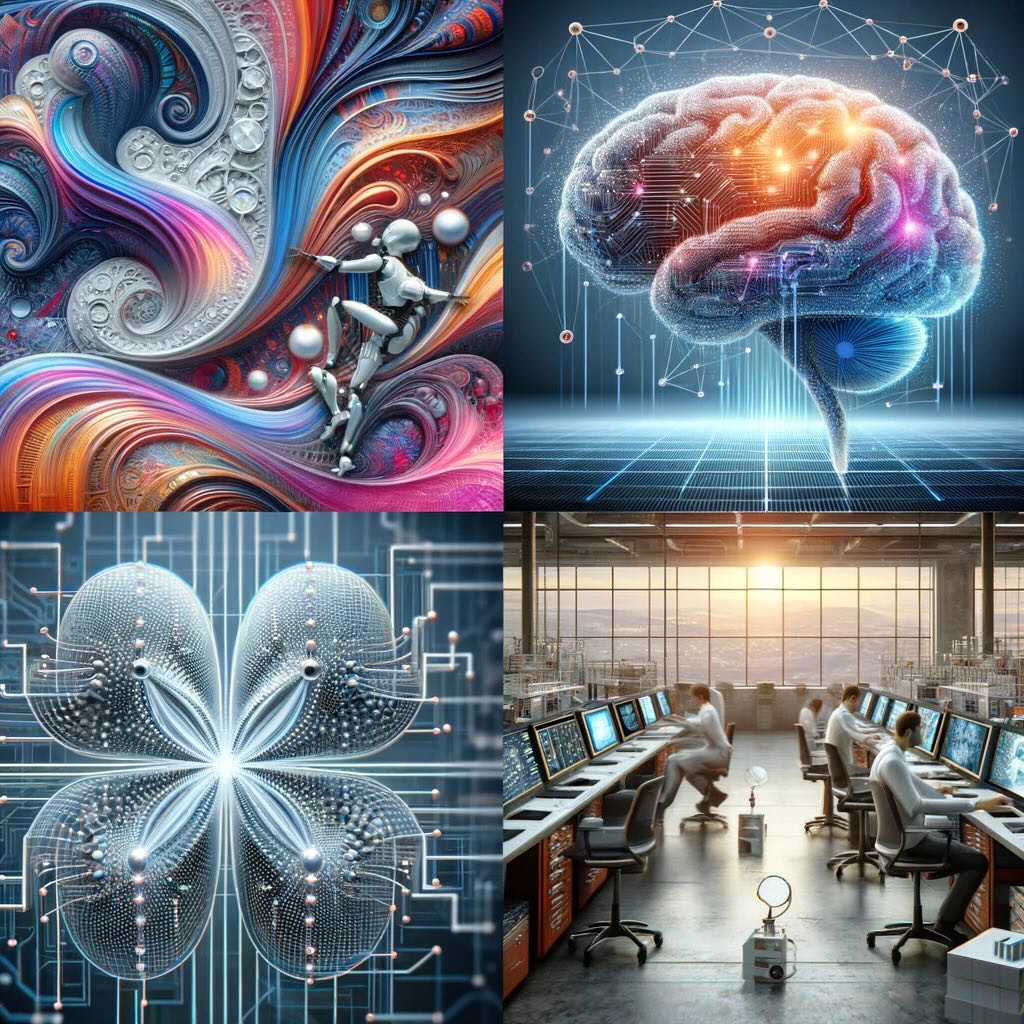Are you looking to integrate the latest AI technologies into your product design and development process? Follow Convergence Consulting to explore how we can transform your ideas into reality with the power of our expertise and best-in-class technologies. In this article, we will talk about Generative AI, Machine Learning, and Deep Learning.
Generative AI, Machine Learning, and Deep Learning
A trio of interconnected technologies reshaping numerous industries, including industrial product design and development. This article delves into each of these technologies, explores their interconnections, and highlights their potential benefits in the realm of product design and development.
“Generative AI: The Art of Digital Creation” is a fascinating concept that encapsulates the transformative potential of AI in the realm of creative and design processes. Here’s an amplified and detailed exploration of this idea:
Generative AI: A Comprehensive Overview
Generative AI encompasses a variety of techniques within artificial intelligence that are geared towards the creation of new, original content. This can include text, images, music, videos, or complex 3D models. Unlike conventional AI systems primarily focused on analysis, classification, or prediction, Generative AI is about creating something new and unique.
Key Characteristics of Generative AI
Pattern Learning and Recognition: At its core, Generative AI involves learning from existing data. By analyzing vast amounts of data – whether images, texts, or design patterns – these systems learn intricate patterns and relationships within the data.
Innovation in Data Generation: Post-learning, these systems can generate new data instances that reflect the learned patterns. The results can range from entirely new concepts to variations of existing ones, often surpassing the creative constraints of human designers.
Diversity and Variation: One of the most striking features of Generative AI is its ability to produce a wide range of outcomes from a single set of inputs. This diversity in output ensures a breadth of creative options.
Applications in Product Design
In the context of product design, the potential applications of Generative AI are vast and transformative.
- Rapid Conceptualization: Generative AI can swiftly generate numerous design concepts based on specified criteria or past designs. This can significantly accelerate the initial stages of the design process, where ideation and conceptual diversity are crucial.
- Iterative Design: With its ability to rapidly produce variations, Generative AI is ideal for iterative design processes. It can tweak designs based on feedback loops, continually refining and evolving the product.
- Customization and Personalization: Generative AI can tailor designs to meet specific user preferences or requirements, allowing for a high degree of customization that would be time-consuming and complex for human designers.
- Complex Problem Solving: Some design challenges are too complex for traditional methods. Generative AI can navigate these complexities, offering solutions that balance multiple design constraints and objectives.
- Predictive Design: By analyzing trends and patterns in user data, Generative AI can predict and create designs that cater to future needs and preferences, staying ahead of market trends.
Technological Underpinnings
Generative AI employs several advanced algorithms and models:
- Generative Adversarial Networks (GANs): Used for generating realistic images and videos, GANs involve two neural networks (generator and discriminator) that work against each other to produce increasingly refined outputs.
- Variational Autoencoders (VAEs): These are used for generating complex data like music or speech. VAEs can compress data into a lower-dimensional representation and then generate new data from this compressed form.
- Transformer Models: Particularly in text generation and natural language tasks, transformer models like GPT (Generative Pretrained Transformer) have shown remarkable abilities in generating coherent and contextually relevant text.
Conclusion and Future Outlook
Integrating Generative AI into the product design process marks a significant leap in digital creation. It enhances the efficiency and breadth of the design process and opens up new realms of creativity and innovation. For businesses like Convergence Consulting, embracing Generative AI can lead to groundbreaking advancements in product development, offering clients cutting-edge, tailored solutions that push the boundaries of conventional design. In a world where speed, innovation, and personalization are key, Generative AI is a pivotal tool in the arsenal of designers and engineers, shaping the future of product creation.
Machine Learning (ML): The Backbone of Modern AI
Machine Learning (ML) is a branch of AI that enables systems to learn and improve from experience without being explicitly programmed. It involves training algorithms on a data set, allowing them to make inferences or predictions. ML can be broadly classified into supervised learning, unsupervised learning, and reinforcement learning. In industrial design, ML can be used for predictive maintenance, optimization of manufacturing processes, and even in customer preference analysis to inform design choices. Machine Learning is a subset of AI that enables machines to improve at tasks with experience. It involves algorithms that can learn from and make predictions or decisions based on data. Here’s an overview:
- Supervised Learning: This method uses labeled datasets to train algorithms. It involves input-output pairs where the model learns to map inputs to outputs. For example, the algorithm learns from labeled emails (spam or not spam) to classify new emails in spam detection.
- Unsupervised Learning: In unsupervised learning, the data used for training is not labeled. The system tries to learn patterns and structures from the data. Common techniques include clustering (grouping similar items) and dimensionality reduction (simplifying data without losing its essence).
- Semi-Supervised Learning: This approach combines labeled and unlabeled data, which is useful when acquiring a fully labeled dataset is expensive or time-consuming.
- Reinforcement Learning: is a technique where an agent learns to make decisions by performing specific actions and observing the rewards/results of those actions. It’s commonly used in scenarios like game playing or robotic navigation.
Deep Learning (DL): A Subset with Depth
Deep Learning, a subset of ML, is inspired by the brain’s structure and function, specifically the human brain’s interconnected neuron layers, called artificial neural networks. This method is particularly powerful in handling unstructured data like images and complex patterns, making it ideal for tasks such as visual recognition, speech recognition, and language translation. In product development, deep learning can be instrumental in advanced simulation, visual design analysis, and enhancing the capabilities of robotic systems in manufacturing.
- Neural Networks: The basic unit of a neural network is a neuron, and each neuron’s output is determined by a nonlinear function of the sum of its inputs. Neural networks consist of layers of these interconnected neurons.
- Convolutional Neural Networks (CNNs): Widely used in image recognition, these networks employ a mathematical operation called convolution. CNNs efficiently process data with a grid-like topology (images, for instance).
- Recurrent Neural Networks (RNNs): are Ideal for sequential data (e.g., time series or text). RNNs have the unique feature of retaining information from previous inputs by creating loops in the network.
- Generative Adversarial Networks (GANs): Consist of two networks, a generator and a discriminator, that compete against each other. They are commonly used in image generation.
- Transfer Learning: Involves taking a pre-trained model (on a large dataset) and fine-tuning it for a specific task. This is beneficial for tasks where labeled data is scarce.
Applications and Importance: Machine Learning & Deep Learning
- Machine Learning and Deep Learning are used in various fields like finance, healthcare, retail, and more.
- They help in predictive analytics, natural language processing, image and speech recognition, etc.
- They contribute to the development of autonomous systems, like self-driving cars.
Synergies and Links Among Generative AI , Machine Learning & Deep Learning
The synergy between Generative AI, Machine Learning, and Deep Learning is evident in how they build upon and enhance each other:
- Generative AI relies on machine learning algorithms to generate new designs. Deep learning models, with their advanced pattern recognition capabilities, further refine the output, making it more sophisticated and applicable.
- Machine Learning provides the foundational algorithms and learning techniques that power Generative AI systems. As a more advanced form, deep learning pushes the boundaries of what’s possible in pattern recognition and prediction.
- Deep Learning enables more complex, layered analysis, which is critical for handling the intricacies of design and development data.
Applications in Industrial Product Design and Development
In the sphere of industrial product design and development, these technologies offer transformative potential:
- Enhanced Design Innovation: Generative AI can propose unique design alternatives, pushing the boundaries of creativity and functionality.
- Predictive Analytics: ML algorithms can predict market trends, customer preferences, and even potential design flaws, enabling proactive design adjustments.
- Optimization of Manufacturing Processes: Deep learning can optimize manufacturing processes, reducing waste and improving efficiency.
- Quality Control: AI-driven systems can identify defects and ensure high-quality production standards.
- Customization at Scale: Generative AI can produce bespoke design variations, meeting specific customer needs without sacrificing efficiency.
Conclusion and Call to Action
Incorporating generative AI, machine learning, and deep learning into industrial product design and development enhances the design process, streamlines manufacturing, ensures quality and aligns products with market needs. As we embrace these technologies, the potential for innovation and efficiency in product design is boundless.
At Convergence Consulting, we are at the forefront of integrating these cutting-edge technologies into our product design and development processes. Our team of expert engineers is equipped to leverage AI, ML, and deep learning to bring your product visions to life, ensuring they are innovative, efficient, and market-ready.
Are you looking to integrate the latest AI technologies into your product design and development process? Follow Convergence Consulting to explore how we can transform your ideas into reality with the power of our expertise and Best in Class Technologies.
Convergence Consulting: Our DNA
Convergence Consulting, Led by CEO Roberto Pasceri, is a pioneering force in the realm of consulting engineering services. Since our foundation in 1998, we have been devoted in our commitment to excellence, delivering best-in-class engineering services in a rapidly evolving world where product design and development stand as key pillars for a successful business.
Nestled in the historic city of Bologna, Italy, and extending our expertise to the vibrant landscapes of Bangkok, Thailand, through our partner company, Innovation Code Ltd., we represent a synthesis of tradition and innovation.
At Convergence Consulting, the key to successful product development lies in a holistic approach. Our services span the entire range of the product lifecycle – from the beginning stages of concept development, through meticulous analysis and design, to the actualization of prototypes and the delivery of finished turnkey products. This comprehensive approach ensures that we not only meet but exceed the expectations of our diverse clientele.
Our unique model, the Convergence Excellence Innovation Network (C.E.I.N), sets us apart, which embodies a flexible and integrated global network. This model enables us to harness the collective expertise of over 20 seasoned engineers, ensuring that each project is imbued with cutting-edge innovation and technical proficiency. Whether it’s in-house at our headquarters or outsourced to client company premises, our team is equipped to handle any project request with unparalleled expertise and dedication.
As we navigate through the constantly evolving landscape of engineering and design, our goal remains steadfast: to be the beacon of innovation and excellence in the consulting engineering domain. Through this article, we invite you to delve deeper into the world of Convergence Consulting, where each project is a journey of discovery, innovation, and unparalleled expertise.


Leave a Reply